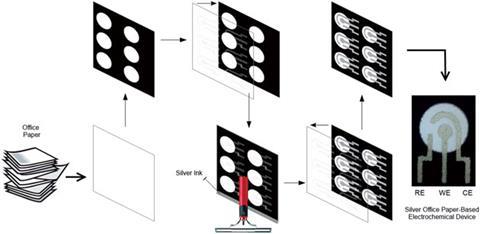Commonplace equipment can turn office paper into cheap, portable and disposable electrochemical devices that are ideal for using in remote locations.
The simple sensors from William de Araujo and Thiago da Paixão at the University of São Paulo, Brazil combine silver ink with ordinary office paper. Office paper is 97% cheaper than the chromatography paper commonly used in cutting-edge paper-based sensors.
According to Araujo, the huge advantage of their sensing device is that fabrication is very simple and all the required materials and equipment are readily available. As he puts it, ‘it is possible to fabricate the sensor without needing to be in a university or in a sophisticated laboratory. This permits analysis in remote places without laboratory infrastructure, eliminating the need for well-trained people.’
A sheet of office paper is printed with wax to form a pattern of circular hydrophilic cells and a template is used to paint silver ink onto the paper to form electrodes. Each cell can then be cut out to form a three-electrode electrochemical device. Used with a potentiostat, these devices can detect picric acid, an explosive, and lead, a component of gunshot residue. They also have sensitivity towards chloride ions and heavy metals which could lead to their application in environmental monitoring.

Nicolò Dossi, an expert in paper-based analytical devices from the University of Udine in Italy, is impressed by these ‘simple and inexpensive, yet efficient and sensitive analytical devices’. He says they ‘appear particularly advantageous for resource limited settings, school laboratories and developing countries.’
Araujo and da Paixão are now working to develop their system into a cheap alternative to the glucometer test strips that are used to monitor glucose levels in patients with diabetes.
References
This paper is free to access until 30 April 2014. Download it here:
W R de Araujo and T R L C da Paixão, Analyst, 2014, DOI: 10.1039/c4an00097h






No comments yet